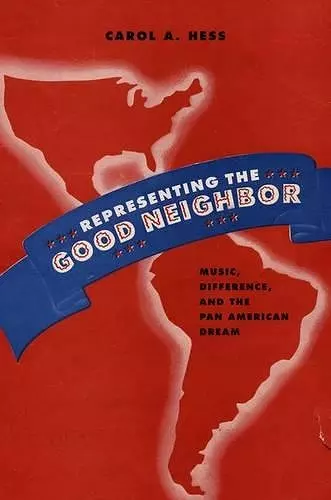Representing the Good Neighbor
Music, Difference, and the Pan American Dream
Format:Hardback
Publisher:Oxford University Press Inc
Published:28th Nov '13
Currently unavailable, and unfortunately no date known when it will be back

In Representing the Good Neighbor, Carol A. Hess investigates the reception of Latin American art music in the US during the Pan American movement of the 1930s and 40s. An amalgamation of economic, political and cultural objectives, Pan Americanism was premised on the idea that the Americas were bound by geography, common interests, and a shared history, and stressed the psychological and spiritual bonds between the North and South. Threatened by European Fascism, the US government wholeheartedly embraced this movement as a way of recruiting Latin American countries as political partners. In a concerted effort to promote a sameness-embracing attitude between the US and Latin America, it established, in collaboration with entities such as the Pan American Union, exchange programs for US and Latin American composers as well as a series of contests, music education projects, and concerts dedicated to Latin American music. Through comparisons of the work of three of the most prominent Latin American composers of the period - Carlos Chávez, Heitor Villa-Lobos and Alberto Ginastera - Hess shows that the resulting explosion of Latin American music in the US during the 30s and 40s was accompanied by a widespread - though by no means universal - embracement by critics as an exemplar of cosmopolitan universalism. Aspects shared between the music of US composers and that of their neighbors to the south were often touted and applauded. Yet, by the end of the Cold War period, critics had reverted to viewing Latin American music through the lens of difference and exoticism. In comparing these radically different modes of reception, Hess uncovers how and why attitudes towards Latin American music shifted so dramatically during the middle of the twentieth century, and what this tells us about the ways in which the history of American music has been written. As the first book to examine in detail the critical reception of Latin American music in the United States, Representing the Good Neighbor promises to be a landmark in the field of American music studies, and will be essential reading for students and scholars of music in the US and Latin America during the twentieth-century. It will also appeal to historians studying US-Latin America relations, as well as general readers interested in the history of American music.
The breadth of research presented in Representing the Good Neighbor expands its potential audience, and the presence today of Latinos as the largest minority in the United States gives the work added significance. Readers who are unaware of the intense collaboration that took place between US and Latin American artists and intellectuals during this era of pan-American accord will be surprised to discover a period in which our collective vision of 'American' music (and 'America' itself) extended far beyond US borders ... Representing the Good Neighbor is a compelling contribution to the deterritorialization of Americanist musicology, one whose model vantage point is capable of discerning cultural sameness without expunging cultural difference. * Journal of the American Musicological Society *
This brilliant book offers the first critical analysis of the reception of Latin American art music in the US during and after the Cold War... Highly recommended. * Choice *
ISBN: 9780199919994
Dimensions: 236mm x 160mm x 28mm
Weight: 612g
336 pages